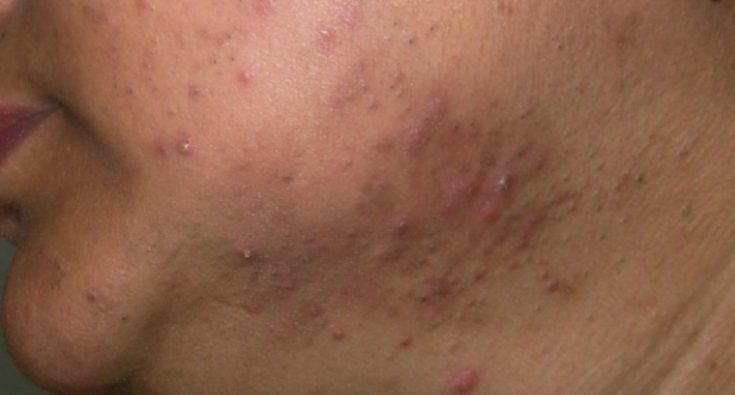Acne occurs in both adolescence and adulthood, including menopausal women. Etiology of menopausal acne – It is multifactorial, but the main cause of the disease is hormonal imbalance - hyperandrogenism. Insulin resistance, hyperprolactinemia, thyroid pathology, and trigger factors also play a role in this problem. The approach to treatment of acne in menopausal women always depends on the severity of the disease and the diagnosed causes of its occurrence.
- Etiology and pathogenesis of acne during menopause
- Clinical features of menopausal acne
- Acne in menopause: topical and systemic therapy
Etiology and pathogenesis of acne during menopause
The mechanisms that lead to the appearance of rashes on the face in women during menopause are not fully understood, but hyperandrogenism plays a major role. Levels of estrogen drop rapidly during this period, while androgen levels decrease gradually. Androgen secretion is dependent on Luteinizing Hormone (LH), which rises significantly during menopause.
Hormonalth imbalance is further increased due to a decrease in the level of sex hormone-binding globulins.
Thus, acne in menopausal women is the result of a relative excess of androgen secretion.
Increased receptor sensitivity to androgens such as dihydrotestosterone and dihydroepiandrosterone sulfate increases the likelihood of developing acne.
The sebaceous gland is a neuroendocrine organ under the control of androgens, neuropeptides, histamine, vitamin D, retinoids, and insulin-like growth factor 1 (IGF-1). There is a complex relationship between IGF-1, insulin and androgens that may contribute to the development of menopausal acne.
Follow us on Instagram!
One of the main triggers for and acne exacerbations in menopausal women is stress:
During stress, levels of corticotropin-releasing hormone increase, which causes increased expression of 3β-hydroxysteroid dehydrogenase, which is responsible for the conversion of dehydroepiandrosterone to testosterone.
The state of relative hyperandrogenism in women in the period of menopause is associated with obesity, as it is one of the factors in the development of insulin resistance and hyperinsulinemia. This, in turn, increases androgen levels, with insulin acting as a co-gonadotropin. In addition, hyperinsulinemia directly reduces the level of sex hormone-binding globulins in the blood serum, aggravating hyperandrogenism.
Clinical features of menopausal acne
The most common manifestation of acne in menopausal women is the presence of inflammatory papulopustular elements in the area of the lower jaw and chin.
Read also: Acne in women of reproductive age
Another possibility would be open comedones, closed comedones, and inflammatory papules all over the face.

Inflammatory papules and nodules, deep-seated in the perioral region, may also be observed during menopause. Such elements, as a rule, cause prolonged erythema, lead to pigmentation and scarring, and are difficult to treat. Another variant of menopausal acne is the presence of closed comedones, visible when the skin is stretched, in combination with enlarged pores in the nose and cheekbones.
Acne during menopause: topical and systemic therapy
Topical therapies should be chosen carefully so as not to overdry already dry skin in menopausal women due to estrogen deficiency. It is worth considering the presence of post-acne, which become more noticeable due to age-related skin changes.
Topical retinoids are the mainstay of therapy and have the added benefit of acting on the signs of skin aging. Adapalene is effective and well tolerated by patients in this age group of patients. In addition to comedone reduction, it has an anti-inflammatory effect on papules.
Read also: Topical retinoids – the gold standard for acne treatment
Retinoids, like benzoyl peroxide, should be used with caution to avoid the side effects of skin irritation and dryness. Recommended use of benzoyl peroxide at a concentration of 2.5% cream.
The use of azelaic acid will be beneficial for post-acne patients.
Follow us on Facebook!
Dapson has proven to be effective and well tolerated when used 2 times a day as maintenance monotherapy in older women in studies. Its advantage is that there is no risk of developing bacterial resistance.
Read also: Acne treatment: new possibilities
Antiandrogens, combined oral contraceptives, isotretinoin, and systemic antibiotics are used to treatmoderate to severe acne and resistant and recurrent acne in older women.
Spironolactone has an antiandrogenic effect by blocking the activity of 5α-reductase and androgen receptor activity in peripheral tissues, and is the drug of choice among antiandrogens in menopausal women.
If acne recurs immediately after a course of isotretinoin, an endocrine disorder should be suspected.Combined oral contraceptives, although effective, have a high risk of developing thromboembolic complications in menopausal women.
Acne inmenopausal women is mainly the result of hormonal imbalances and exposure to trigger factors. relative hyperandrogenism and stress play a key role in the development of pathology. Long-term topical therapy with judicious use of systemic drugs is the preferred tactic for menopausal acne because of the clinical features of the disease: deeper location, tendency to resistance to therapy, long duration. Combination therapy with benzoyl peroxide, topical retinoids and azelaic acid is recommended as first line according to the patient's skin and individual tolerance.
More interesting stuff on our YouTube channel:







Add a comment